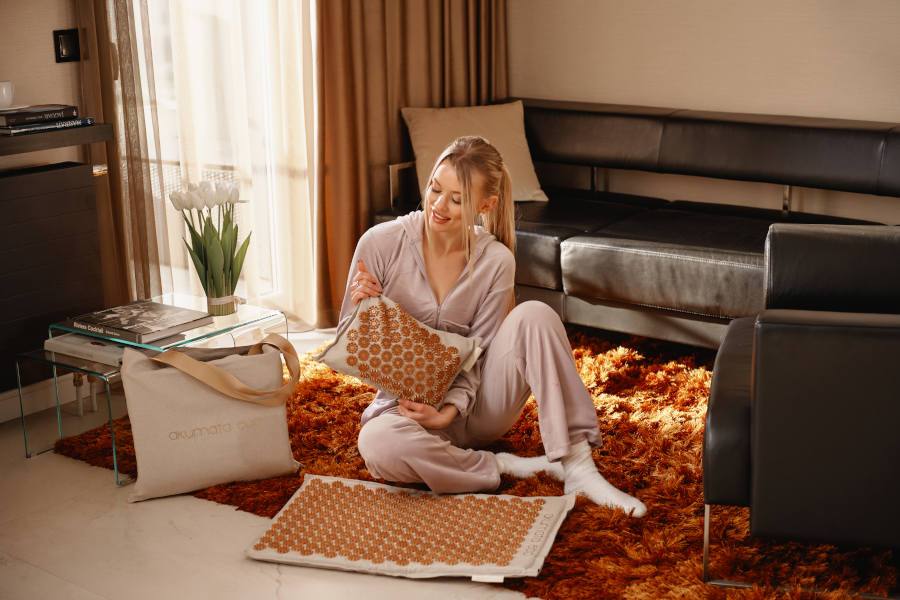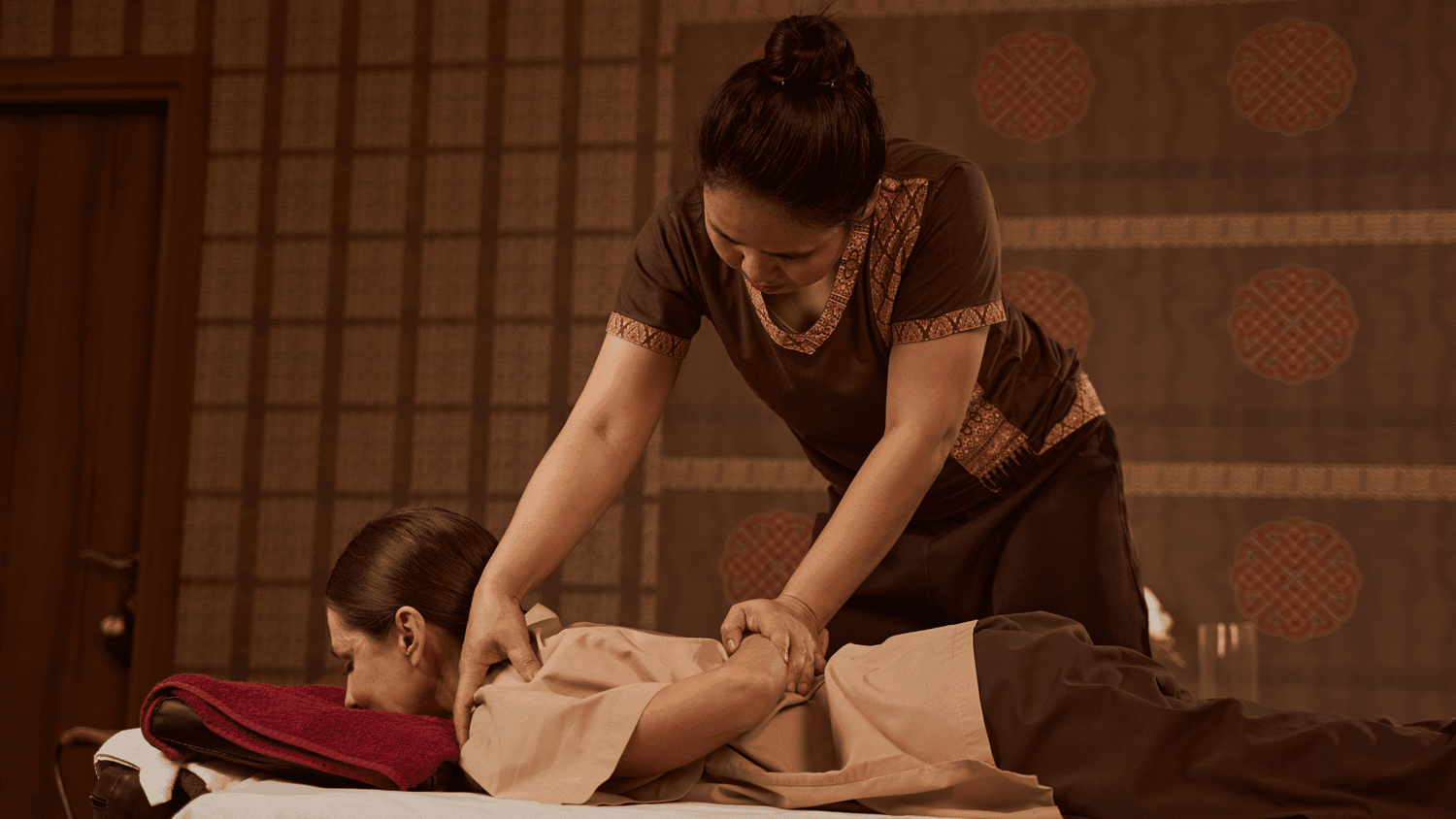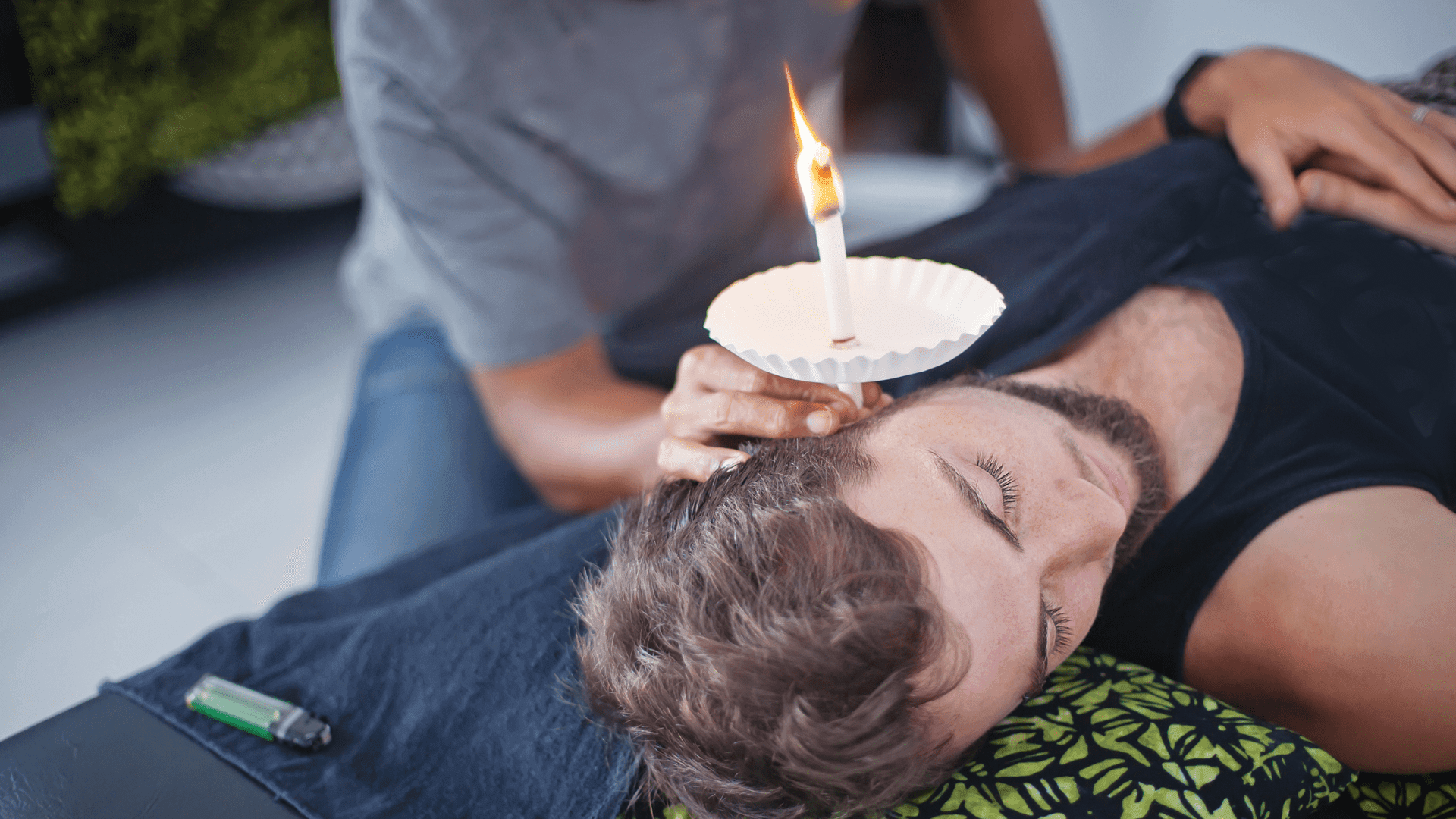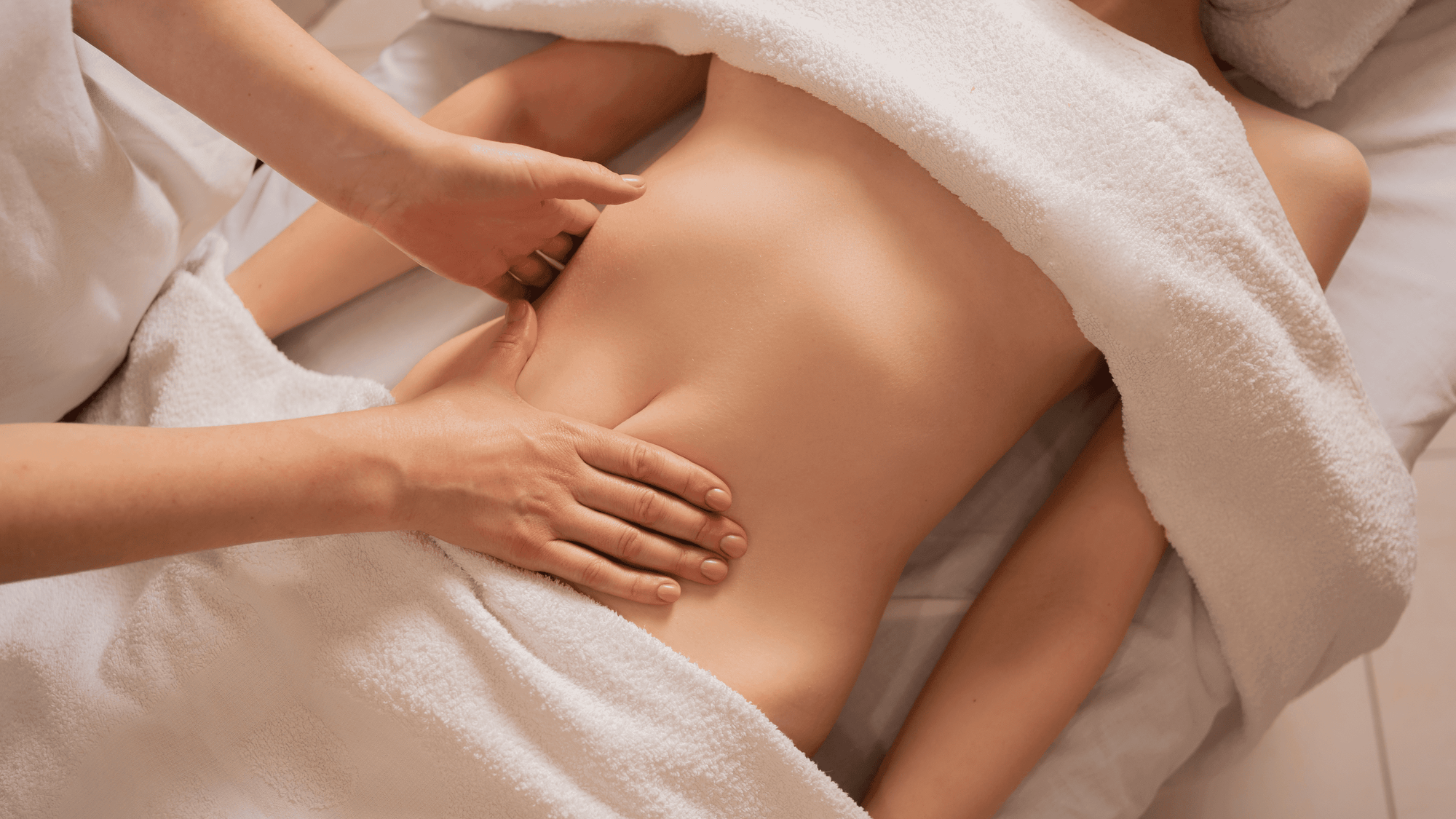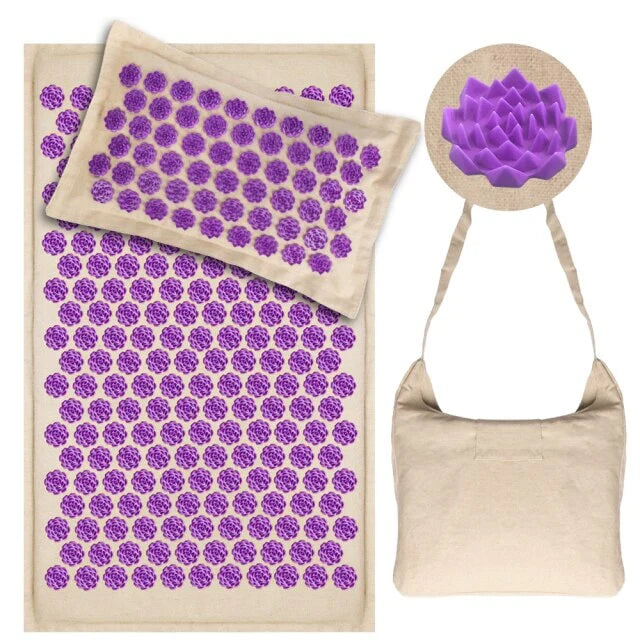Thai massage, an ancient healing practice, originated in India more than 2,500 years ago and later found its way to Thailand. It combines acupressure, Indian Ayurvedic principles, and assisted yoga postures to create a unique therapeutic experience.
Unlike Western massage techniques, Thai massage does not use oils and is performed on a floor mat or mattress. It focuses on stretching and deep massage, aiming to improve the flow of energy along sen lines throughout the body. This form of massage is often seen as both an art and a science, deeply rooted in traditional Thai medicine and public health practices.
Techniques of Thai Massage
Fundamental techniques
Thai massage employs a variety of techniques, including rhythmic pressing, acupressure, and passive stretching. Practitioners use their hands, elbows, knees, and feet to apply deep pressure along the body's sen lines, or energy lines.
Assisted yoga poses help to stretch and relax the muscles, enhancing flexibility and promoting relaxation. These techniques work together to alleviate muscle tension, relieve headaches, and improve overall body function. The combination of these elements makes Thai massage a unique and comprehensive type of massage.
Tools and equipment
In traditional Thai massage, a floor mat is used to allow the therapist to use their body weight effectively during the session. Unlike other types of massage, Thai massage typically does not use oils, focusing instead on direct muscle manipulation and passive stretching.
Massage chairs and massage tables are less commonly used, as the traditional practice involves a more hands-on approach on the floor. The simplicity of the equipment emphasizes the traditional roots and the holistic nature of this massage technique.
Detailed technique descriptions
Thai massage has two primary styles: Nuad Bo-Rarn (Northern style) and Nuad Chaleeysak (Southern style). The Northern style, often taught in Chiang Mai, emphasizes slow, meditative movements and gentle stretches, while the Southern style, commonly practiced in Bangkok, incorporates more acupressure and rhythmic pressure techniques.
Each style has its own unique approach, offering different therapeutic benefits. Visual aids such as images or diagrams can help illustrate these positions and movements, enhancing the understanding of this intricate practice.
Health benefits of Thai Massage
Physical benefits
Thai massage offers numerous physical benefits, including increased flexibility, improved blood flow, and significant pain relief. The stretching and pressure techniques enhance joint mobility and muscle elasticity, helping to relieve tension and discomfort.
Regular sessions can reduce chronic pain, especially in the back and shoulders, and are effective in easing headaches. Stress reduction is another major benefit, as the massage helps to release tension and promote relaxation. Studies have shown that Thai massage can improve overall physical health and increase energy levels.
Mental and emotional benefits
Beyond physical health, Thai massage also supports mental and emotional well-being. It can reduce anxiety and depression by promoting relaxation and a sense of calm. Improved sleep quality is a common benefit, as the massage helps to balance the body's energy.
Enhanced mental clarity and focus often follow, making it a holistic therapy for both body and mind. Researchers have found that the meditative aspects of Thai massage can be highly beneficial for mental health, contributing to a more balanced and peaceful state of mind.
Scientific evidence
Scientific studies have supported many of the claimed benefits of Thai massage. Research indicates that it can significantly lower stress levels, improve range of motion, and enhance overall physical performance. For instance, studies published in various medical journals highlight how Thai massage can improve flexibility and range of motion, particularly in the spine and upper body.
Quotes from experts and infographics summarizing these findings can help convey the credibility and effectiveness of Thai massage, reinforcing its therapeutic value and its place in traditional and modern medicine.
What to expect during a Thai Massage?
Preparation and setup
Before a Thai massage session, it’s essential to wear loose, comfortable clothes that allow for a full range of motion. Unlike other massages, you will remain fully clothed throughout the session. It’s also advisable to avoid heavy meals beforehand to ensure comfort during the stretching and pressing movements.
Preparing mentally for a relaxing experience can also enhance the benefits. This type of massage involves a series of passive stretching and deep pressure techniques, requiring the person to be relaxed and ready to engage fully with the process.
The session
A typical Thai massage session lasts between 60 to 90 minutes, though some can extend to two hours. The session begins with the therapist assessing your needs and areas of tension. The massage then progresses through a series of rhythmic pressing, stretching, and acupressure techniques.
The therapist applies pressure along the sen lines, aiming to balance the body's internal energy flow. Communication with the therapist is key to ensuring the pressure and stretches are comfortable and effective for you. The entire body is treated, from head to toes, ensuring a comprehensive therapeutic experience.
Post-massage care
After a Thai massage, it’s important to stay hydrated to help flush out toxins released during the session. Resting and allowing your body to recover can enhance the benefits of the massage. Gentle stretching exercises can help maintain the flexibility gained.
A video guide for post-massage exercises can be a useful tool for continuing the benefits at home. Consulting a doctor for advice on integrating Thai massage into your regular wellness routine can also be beneficial, especially if you have specific health conditions or concerns.
Risks and considerations
Potential side effects
While Thai massage is generally safe, some people may experience muscle soreness or bruising, especially if they are not used to deep tissue work. It’s important to communicate any discomfort during the session to the therapist.
Minor side effects typically resolve within a few days, but being aware of them helps manage expectations. If you experience any severe pain or unusual symptoms, it’s worth consulting a doctor to rule out any underlying issues.
Contraindications
Certain individuals should avoid Thai massage, including pregnant women, people with severe osteoporosis, and those with recent injuries or surgeries. Always consult with a healthcare provider before trying Thai massage if you have any medical conditions.
Ensuring the massage is suitable for your health needs can prevent potential complications. Traditional Thai medicine often considers the holistic health of the person, and a thorough understanding of one’s health condition is crucial.
Safety tips
Choosing a qualified therapist is crucial for a safe and effective Thai massage. Look for certifications and reviews to find a reputable practitioner. A safe environment is also important; ensure the space is clean and comfortable.
Quotes from medical professionals can provide additional insights into ensuring a safe massage experience. Visiting reputable massage parlors or spas in Thailand, such as those certified by Wat Pho, can ensure high standards of practice and hygiene.
Thai massage vs. other massage techniques
Comparison with Swedish massage
Swedish massage focuses on long, gliding strokes, kneading, and circular movements on superficial layers of muscles using massage oils. In contrast, Thai massage involves more dynamic stretches and deep, targeted pressure along the sen lines without oils.
Diagrams comparing these techniques can visually highlight the differences, helping you choose the right one for your needs. Swedish massage is more about relaxation, while Thai massage is more about therapeutic stretching and energy balancing.
Comparison with deep tissue massage
Deep tissue massage targets deeper layers of muscles and connective tissue, often using slower strokes and more intense pressure to release chronic muscle tension. Thai massage, while also addressing deep tissue, incorporates stretching and acupressure, offering a more holistic approach.
Understanding these differences can guide you in selecting the most beneficial massage for your body. Both types of massage can be effective in relieving chronic pain, but Thai massage also focuses on improving overall flexibility and energy flow.
Unique aspects of Thai massage
Thai massage’s holistic approach sets it apart from other techniques. It integrates elements of yoga and acupressure, focusing on the body’s energy flow through the sen lines. This comprehensive method aims to balance the body’s energy, promoting overall wellness.
The combination of physical and energetic work makes Thai massage a unique and deeply therapeutic experience. Traditional Chinese medicine and traditional Thai medicine both emphasize the importance of energy flow and balance, and Thai massage embodies these principles.
The cultural and spiritual aspects of Thai massage
Connection to Thai culture
Thai massage is deeply rooted in Thai culture and daily life. It is often practiced in temples and homes, reflecting its significance in Thai traditions. Wat Pho, one of Bangkok’s most famous temples, is renowned for its massage school and traditional medical teachings.
Festivals and events celebrate this ancient practice, highlighting its cultural importance. Understanding its cultural roots can enrich your appreciation of Thai massage, as it is an integral part of the heritage and daily practices of the people of Thailand.
Spiritual elements
Thai massage is intertwined with Buddhist practices, emphasizing mindfulness and meditation. Practitioners often incorporate these elements into the massage, creating a meditative and healing experience.
This spiritual connection enhances the therapeutic effects, offering a profound sense of relaxation and inner peace. The spiritual aspect of Thai massage is not only about physical healing but also about connecting the mind, body, and spirit, aligning with the holistic principles of traditional medicine.
Practical guide to Thai massage
Finding a qualified therapist
To experience the full benefits of Thai massage, it’s essential to find a qualified therapist. Look for practitioners with proper certification and positive reviews. Recommendations from friends or online platforms can also help.
Choosing the right therapist ensures a safe and effective massage experience. Visiting reputable massage parlors or spas, such as those recommended by the Bangkok Post, can also provide assurance of quality and professionalism.
Self-practice techniques
For those interested in trying Thai massage techniques at home, simple self-practice methods can be beneficial. Techniques such as gentle stretching and acupressure can be performed with minimal guidance.
Video tutorials can provide step-by-step instructions, making it easy to incorporate these practices into your daily routine. While self-practice can be beneficial, it’s always recommended to receive training from a qualified professional to ensure the techniques are performed correctly and safely.
Integrating Thai massage into your routine
Regular Thai massage sessions can significantly enhance your overall well-being. It’s recommended to have a session once or twice a month to maintain flexibility and reduce stress. Combining Thai massage with other wellness practices like yoga and meditation can further amplify its benefits, creating a holistic approach to health.
Understanding the role of traditional medical practices and how they can complement modern wellness routines can provide a comprehensive strategy for maintaining health.
Future trends and innovations in Thai massage
Modern adaptations
Thai massage is evolving with modern adaptations, incorporating new techniques and styles to meet diverse needs. Innovations include integrating other therapeutic practices such as aromatherapy and reflexology.
These modern adaptations make Thai massage more accessible and versatile, catering to a wider audience. The evolution of Thai massage reflects its enduring relevance and adaptability in the modern wellness landscape.
Technology and Thai massage
Advancements in technology are also influencing Thai massage. Apps and online platforms offer virtual sessions and tutorials, making it easier to learn and practice at home. These resources provide access to high-quality instruction and information, expanding the reach and impact of Thai massage.
Technology can also facilitate better education and training for massage therapists, ensuring that traditional techniques are preserved and passed down accurately.
Global influence
Thai massage is gaining popularity worldwide, influencing global wellness trends. Its holistic approach resonates with people seeking natural and effective health solutions. As its popularity grows, Thai massage continues to evolve, adapting to different cultures and preferences while maintaining its traditional essence.
The global spread of Thai massage has also led to increased interest in its cultural and historical origins, fostering greater appreciation and understanding of this ancient practice.
Conclusion
Recap of key points
Thai massage offers a unique blend of stretching, acupressure, and assisted yoga, providing numerous physical and mental benefits. Understanding its techniques, benefits, and cultural significance can enhance your appreciation and experience of this ancient practice.
From improving flexibility and range of motion to relieving tension and stress, Thai massage is a comprehensive and deeply therapeutic form of massage.
Frequently asked questions about Thai massage
1. What is Thai massage?
Thai massage, also known as Thai yoga massage, is a traditional healing practice that combines acupressure, Indian Ayurvedic principles, and assisted yoga postures. It originated in India over 2,500 years ago and later became an integral part of massage therapy in Thailand. Unlike Western massage techniques, Thai massage does not use oil and is performed on a floor mat.
The therapist uses their hands, elbows, knees, and feet to apply pressure and perform rhythmic stretching, which helps improve flexibility, ease joint pain, and balance the body's energy flow along the sen lines. This form of treatment is seen as both an art and a science, deeply rooted in traditional Thai medicine and public health practices.
2. What are the benefits of Thai massage?
Thai massage offers numerous benefits for both physical and mental well-being. Physically, it increases flexibility, improves blood circulation, relieves muscle tension, and alleviates chronic pain, especially in the back and shoulders. Mentally, it reduces stress and anxiety, enhances relaxation, and improves sleep quality.
Scientific studies have shown that Thai massage can also boost energy levels and enhance athletic performance. This type of massage is particularly effective in improving overall body function and promoting holistic health. The intensity of the massage can be adjusted to suit individual needs, making it suitable for a wide range of people.
3. How is Thai massage different from Swedish massage?
Thai massage differs from Swedish massage in several key ways. While Swedish massage uses long, gliding strokes, kneading, and circular movements with oils to relax the superficial muscles, Thai massage involves deep pressure, assisted yoga poses, and stretching without oils. Thai massage is performed on a floor mat, allowing the therapist to use their body weight for deeper pressure.
It focuses on the body's energy lines (sen lines), aiming to balance internal energy and improve flexibility. In contrast, Swedish massage primarily targets muscle relaxation and improved circulation. Thai vs. deep tissue massage also shows distinct differences, as deep tissue targets deeper muscle layers with slower strokes.
4. What should I expect during a Thai massage session?
During a Thai massage session, you will remain fully clothed in loose, comfortable clothes. The session usually lasts between 60 to 90 minutes, though some can extend to two hours. The therapist will apply rhythmic pressing, acupressure, and assisted yoga stretches along your body's sen lines.
Communication with the therapist is crucial to ensure the pressure and stretches are comfortable for you. The session aims to work on the entire body, promoting relaxation, flexibility, and energy flow.
Post-massage, it's recommended to hydrate well and perform gentle stretches to maintain the benefits. The history of Thai massage shows that it is designed to leave you feeling rejuvenated and balanced.
5. Are there any risks or side effects of Thai massage?
While Thai massage is generally safe, it can cause muscle soreness or bruising, especially for those unaccustomed to deep tissue work. It’s important to communicate any discomfort during the session to the therapist. Pregnant women, individuals with severe osteoporosis, and those with recent injuries or surgeries should avoid Thai massage.
Always consult with a healthcare provider before trying Thai massage if you have any medical conditions. Choosing a qualified therapist and ensuring the massage is suitable for your health needs can minimize risks. The intensity of the massage can be adjusted to avoid any adverse effects, making it a safe and beneficial treatment.
6. How often should I get a Thai massage?
The frequency of Thai massage sessions depends on individual needs and health goals. For general wellness and maintenance, having a Thai massage once or twice a month is recommended. For those with chronic pain or specific health conditions, more frequent sessions may be beneficial.
Regular Thai massage can help maintain flexibility, reduce stress, and promote overall well-being. Consulting with a qualified therapist or healthcare provider can help determine the best frequency for your specific needs. The school of thought behind traditional Thai medicine suggests that regular treatments can significantly improve quality of life.
7. Can Thai massage help with headaches?
Yes, Thai massage can be effective in relieving headaches, particularly tension headaches. The deep pressure and stretching techniques used in Thai massage help release muscle tension in the neck, shoulders, and upper back, which are common areas of tightness that can contribute to headaches.
By improving blood flow and reducing stress, Thai massage can alleviate headache symptoms and promote relaxation. For chronic headache sufferers, regular Thai massage sessions may provide significant relief. Studies have shown that targeted pressure and stretching can significantly reduce the frequency and intensity of headaches.
8. What is the role of sen lines in Thai massage?
Sen lines are the body's energy pathways in Thai massage, similar to meridians in traditional Chinese medicine. There are ten primary sen lines, and Thai massage aims to balance the body's energy flow along these lines. By applying pressure and performing stretches along the sen lines, the therapist helps to release blockages and improve the flow of energy.
This promotes overall health and well-being, alleviates pain, and enhances flexibility. Understanding and working with sen lines is a fundamental aspect of the therapeutic effects of Thai massage. Knowledge of these energy lines is crucial for effective treatment.
9. Where can I find qualified Thai massage therapists?
Qualified Thai massage therapists can be found in reputable massage parlors, spas, and wellness centers. In Thailand, Wat Pho in Bangkok is renowned for its traditional Thai massage school and offers high standards of training. Internationally, many therapists receive certification from recognized institutions such as the Thai Massage School of Chiang Mai.
When choosing a therapist, look for certifications, reviews, and recommendations from trusted sources. Visiting reputable establishments ensures a high-quality and safe massage experience. The Bangkok Post often lists reputable massage parlors and therapists, providing a reliable resource for finding qualified professionals.
10. How does Thai massage integrate with traditional Thai medicine?
Thai massage is a vital component of traditional Thai medicine, which also includes herbal medicine, dietary therapy, and spiritual practices. It is used to balance the body's energy, treat ailments, and promote overall health. Traditional Thai medicine views health as a balance of physical, mental, and spiritual elements, and Thai massage plays a crucial role in maintaining this balance.
By improving energy flow, relieving tension, and promoting relaxation, Thai massage supports the holistic health principles of traditional Thai medicine. The integration of Thai massage with other traditional treatments creates a comprehensive approach to wellness.
